Washing machine repair: an overview of 8 popular malfunctions and how to solve them

In Western Europe, no one will be lucky to repair a broken washing machine: they just throw it away and buy a new one in return. In the post-Soviet space, this is not accepted. Each owner pities his technique and tries to give it a second life. Well, and the one who can’t do the repair of washing machines with his own hands will take the unit to a service center. True, most breakdowns can be avoided if a malfunction is noticed in time. Then you can do small, for example, replacing bearings.
Washing machine: device and principle of operation
Looking at how a specialist from the service center returns the machine to working capacity, in seven cases out of ten a thought flashes: “But you could have repaired your washing machine yourself.” But the way it is. If you set a goal, then most of the damage can be eliminated independently. The main thing is to look into the instructions before starting work to get acquainted with the device device.
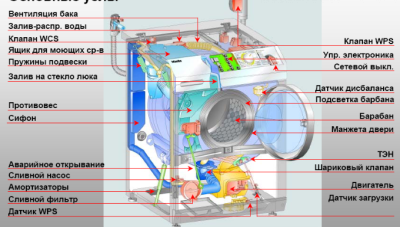
Before disassembling your washing machine, you need to read at least the instruction manual, and even better, study the diagram of a specific model. During the repair, you can record what and in which
The washing machine consists of twenty main units:
- water valves
- programming knob;
- inlet valves;
- inlet hoses;
- stationary tank;
- detergent dispenser;
- suspension spring;
- water level regulator;
- rotating drum;
- a heating element;
- drive belt;
- electric motor;
- pump;
- catchment basin;
- drain riser;
- outlet hose;
- door;
- door latch;
- door seal;
- adjustable legs.
The principle of operation of all automatic machines is the same. The units themselves differ only in washing modes. Let's take a look at the classic process:
- The first wash cycle consists of opening the inlet valve to supply the right amount of water to the drum. After reaching the level set by the regulator, the intake valve closes.
- With the inclusion of the element and the heating of water, the second wash cycle begins. If the temperature sensor in the car is not installed, it means that the heater is turned off by a timer. Simultaneously with the heater, an electric motor is started. It does not spin at maximum speed. As a rule, at this stage, the drum rotates in both directions at different time intervals.
- In the third cycle, the pump pumps out dirty water, after which the drum is refilled.
- During the fourth cycle, the engine turns on and the machine rinses the laundry at low speeds. Then the motor is turned off, and the pump again pumps out water.
- At high speeds, the engine turns on already in the fifth cycle and turns off when the “Spin” mode ends. The pump remains on throughout the cycle.
TOP 8 most common failures
In nine out of ten cases, washing machines break down immediately after the warranty period. After four to five years of operation, they begin to make noise, vibrate, or simply stop washing.
Experts identify eight major defects:
- Increased vibration. This defect occurs when more laundry is loaded into the drum than is permitted by the passport or when linoleum sags on which the machine is sitting. When installing, many lose sight of the fact that the technique requires a solid surface and a properly set level. To fix the problem, you need to set the horizontal level with the help of adjustable legs;
- The machine starts to make noise during the spin cycle. This is due to the lack of lubrication in the bearing on the drum axis. After laying a new noise is reduced;
- The output of the heater. Hard water leads to the destruction of the heater. By means of service centers, customers are alerted to the fact that Calgon itself is not a defense. Indeed, it is possible to clean the heating elements only with special descaling agents (Doctor TEN, etc.);
- The drum stops spinning. If the electronics of the machine work, check the voltage on the engine. No voltage - this is a motor defect;
- When the machine starts, water does not accumulate. If you close the inlet valve, the pressure switch contacts must be open. Manufacturers indicate the pressure in the product passport;
- Constantly switching the washing program. In winter, it happens that the washing machine suddenly starts switching programs during washing: the handle simply flips in a circle (older Indesit models especially sin). The reason lies in the too low temperature of the incoming water, which is why the electronics malfunction. After resting or warming, the machine starts working normally again;
- The machine does not drain water during washing. If there is voltage at the inlet of the pump motor, then a foreign object has got into the impeller, which prevents it from rotating. If there is no voltage, the pump motor is out of order;
- The door of the washing machine is locked. In this case, you can run the rinse and spin program again, or turn off the power to the machine for fifteen minutes and turn it on again. In some cars at the very bottom, you can unscrew the cover under which there is an emergency opening cable for the hatch (usually it is orange).
This is what the whole thing looks like:
Procedure for replacing units and parts of the unit
Do-it-yourself repairs to washing machines sometimes take longer than expected. Therefore, it is better to move the unit to a garage or workshop, so as not to interfere with households.
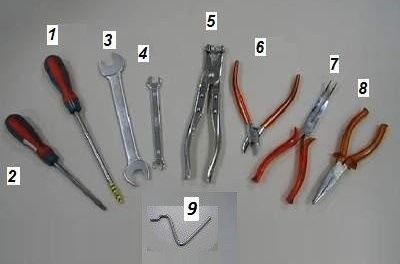
The tool that you will need to disassemble the washing machine: 1 - a cross-shaped screwdriver, 2 - a flat screwdriver, 3 - a flat wrench 19, 4 - a 8/10 flat wrench, 5 - pliers for self-clamping clamps (1472-Beta); 6 - nippers, 7 - pliers, 8 - long bent pliers, 9 - service hook
To replace the heater with a thermostat, you need to remove the service panel. Then the heater is disconnected from the wires and the nut fixing it is unscrewed. Carefully remove the heater from the guide so as not to break it. After installing a new heating element, the machine is assembled in the reverse order.
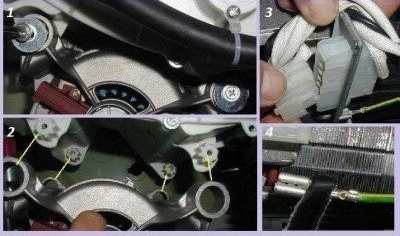
The motor of the washing machine is fixed by two screws. After it is removed, it remains only to disconnect the connector
Before you repair or replace the collector motor of the washing machine, remove the top and service panels and remove the V-belt. Then unscrew the two screws that secure the engine. The part is removed from the stellar protrusions and the electrical connector is disconnected. Further, according to the scheme, a new engine is connected, the car is assembled and a test run is performed.
Before repairing the drain pump of the washing machine, the service panel must be removed. A screwdriver is unscrewed with a cruciform screwdriver, the hoses are disconnected after loosening the clamps. The connector disconnects and a new pump is connected.
If the machine (with mechanical, rather than touch control), after selecting a program and starting, erases only the first cycle, and then gives an error, then the contact on the back of the control handle has failed. On one side, the wire touches the “labyrinth”, and the second is a contact on the board, each relay of which starts a separate process. The control knob is turned by a spring. As it rotates, the wire pulls and closes the relay. If you remove the top cover of the machine, you can easily get to the place of "accident". Usually it turns out that the contact is worn out or bent, less often it jumps out of the “maze” or oxidizes.
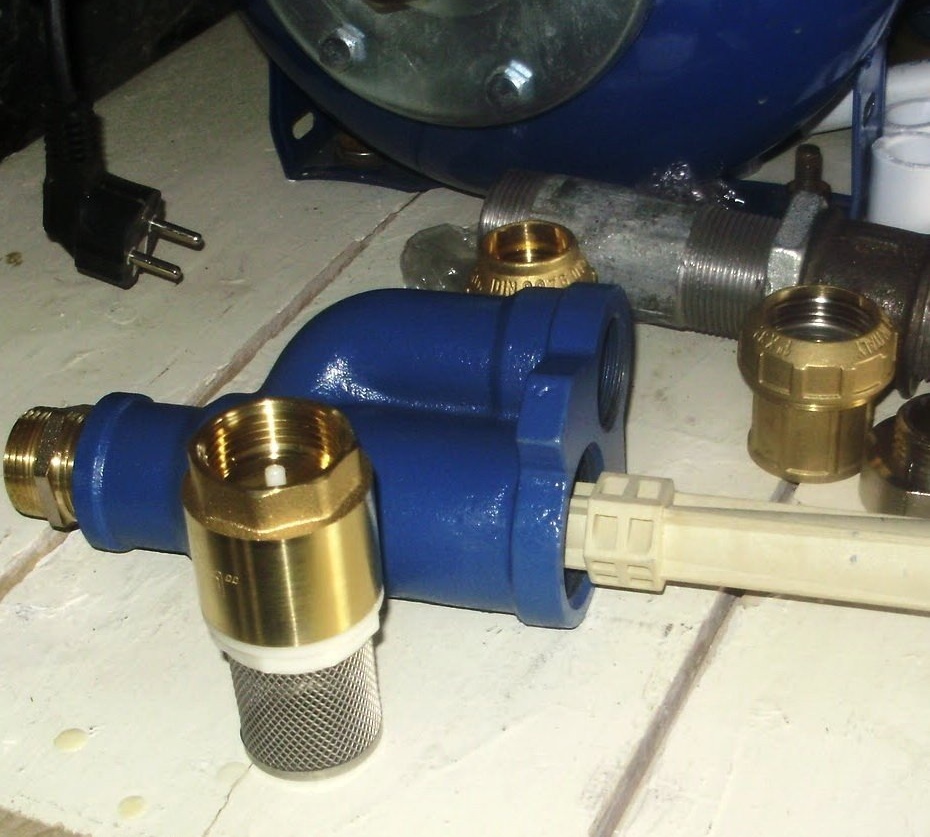
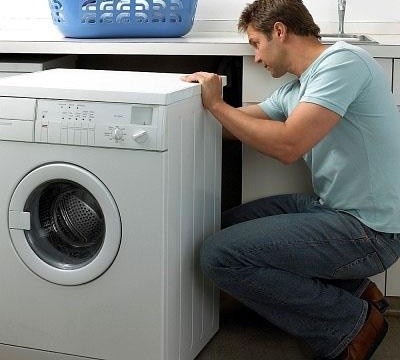
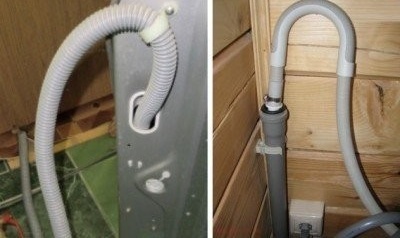
17 comments